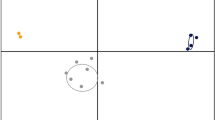Abstract
Robinia pseudoacacia L. is a clonal tree species. To investigate a mutation within eight microsatellite loci of R. pseudoacacia, we analyzed DNA samples obtained from different leaf samples within each ramet, leaves from ramets within the genet, and seeds. Of the eight loci, locus Rops15 (AG motif) displayed hypermutability. The mutation rates of Rops15 within each ramet, among ramets within the genet, and offspring were 6.27% (ranging from 0 to 31.1%), 6.11% (from 0 to 25.0%) and 3.78% (from 0 to 10.9%), respectively. The mutation rate increased with allele size (13–71 repeat units). The mutation patterns observed in Rops15 were distinctive in two ways. First, there was a significant bias toward additions over deletions, and both addition and deletion of single repeats were dominant at alleles with lengths less than 232 bp (63 repeats). Second, for the longest allele of 248 bp (71 repeats), the number of losses was higher than the number of gains. These observations suggest that the mutation patterns of microsatellites in R. pseudoacacia may follow a generalized stepwise mutation model, and that the tendency of long alleles to mutate to shorter lengths acts to prevent infinite growth. Finally, the observation of somatic hypermutability at locus Rops15 highlights the need for caution when using highly polymorphic microsatellites for population genetic structure and paternity analysis in tree species.


Similar content being viewed by others
References
Amos W, Sawcer SJ, Feakes RW, Rubinsztein DC (1996) Microsatellites show mutational bias and heterozygote instability. Nature Genet 13:390–391
Anderson TJC, Su XZ, Roddam A, Day KP (2000) Complex mutations in a high proportion of microsatellite loci from the protozoan parasite Plasmodium falciparum. Mol Ecol 9:1599–1608
Beck NR, Double MC, Cockburn A (2003) Microsatellite evolution at two hypervariable loci revealed by extensive avian pedigrees. Mol Biol Evol 20:54–61
Brohede J, Primmer CR, Møller A, Ellegren H (2002) Heterogeneity in the rate and pattern of germline mutation at individual microsatellite loci. Nucleic Acids Res 29:1997–2003
Cloutier D, Rioux D, Beaulieu J, Schoen DJ (2003) Somatic stability of microsatellite loci in Eastern white pine, Pinus strobus L. Heredity 90:247–252
Di Rienzo A, Peterson AC, Garza JC, Valdes AM, Slatkin M, Freimer NB (1994) Mutational processes of simple-sequence repeat loci in human populations. Proc Natl Acad Sci USA 91:3166–3170
Ellegren H (2000) Heterogeneous mutation processes in human microsatellite DNA sequences. Nat Genet 24:400–402
Glenn TC, Stephan W, Dessauer HC, Braun MJ (1996) Allelic diversity in alligator microsatellite loci is negatively correlated with GC content of flanking sequences and evolutionary conservation of PCR amplifiability. Mol Biol Evol 13:1151–1154
Hoekert WEJ, Neuféglise H, Schouten AD, Menken SBJ (2002) Multiple paternity and female-biased mutation at a microsatellite locus in the olive ridley sea turtle (Lepidochelys olivacea). Heredity 89:107–113
Jeffreys AJ, Neumann R (1997) Somatic mutation processes at a human minisatellite. Hum Mol Genet 6:129–136
Leopoldino AM, Pena SDJ (2002) The mutational spectrum of human autosomal tetranucleotide microsatellites. Hum Mutat 21:71–79
Levinson G, Gutman GA (1987) Slipped-strand mispairing: a major mechanism for DNA sequence evolution. Mol Biol Evol 4:203–221
Li YC, Korol AB, Fahima T, Beiles A, Nevo E (2002) Microsatellies: genomic distribution, putative functions and mutational mechanisms: a review. Mol Ecol 11:2453–2465
Li YC, Fahima T, Rder MS, Kirzhner VM, Beiles A, Korol AB, Nevo E (2003) Genetic effects on microsatellite diversity in wild emmer wheat (Triticum dicoccoides) at the Yehudiyya microsite, Israel. Heredity 90:150–156
Lian C, Hogetsu T (2002) Development of microsatellite markers in black locust (Robinia pseudoacacia) using a dual-suppression-PCR technique. Mol Ecol Notes 2:211–213
Lian C, Oishi R, Miyashita N, Nara K, Nakaya H, Wu B, Zhou Z, Hogetsu T (2003) Genetic structure and reproduction dynamics of Salix reinii during primary succession on Mount Fuji, as revealed by nuclear and chloroplast microsatellite analysis. Mol Ecol 12:609–618
Primmer CR, Saino N, Møller AP, Ellegren H (1998) Unraveling the processes of microsatellite evolution through analysis of germ line mutations in barn swallows Hirundo rustica. Mol Biol Evol 15:1047–1054
Schlötterer C, Ritter R, Harr B, Brem G (1998) High mutation rate of a long microsatellie allele in Drosophila melanogaster providence for allele-specific mutation rates. Mol Biol Evol 15:1269–1274
Steinberg EK, Lindner KR, Gallea J, Maxwell A, Meng J, Allendorf FW (2002) Rates and patterns of microsatellite mutations in pink salmon. Mol Biol Evol 19:1198–1202
Sturzeneker R, Bevilacqua RAU, Haddad LA, Simpson AJG, Pena SDJ (2000) Microsatellite instability in tumors as a model to study the process of microsatellite mutations. Hum Mol Genet 9:347–352
Tautz D (1989) Hypervariability of simple sequences as a general source for polymorphic DNA markers. Nucleic Acids Res 17:6463–6471
Tautz D, Schlötterer C (1994) Simple sequences. Curr Opin Genet Dev 4:832–837
Udupa SM, Baum M (2001) High mutation rate and mutational bias at (TAA)n microsatellite loci in chickpea (Cicer arietinum L.). Mol Genet Genomics 265:1097–1103
Vigouroux Y, Jaqueth JS, Matsuoka Y, Smith OS, Beavis WD, Smith JSC, Doebley J (2002) Rate and pattern of mutation at microsatellite loci in maize. Mol Biol Evol 19:1251–1260
Vorechovsky I, Kralovicova J, Laycock MD, Webster ADB, Marsh SGE, Madrigal A, Hammarstrom L (2001) Short tandem repeat (STR) haplotypes in HLA: an integrated 50-kb STR/linkage disequilibrium/gene map between the RING3 and HLA-B genes and identification of STR haplotype diversification in the class III region. Eur J Hum Genet 9:590–598
Wierdl M, Dominska M, Petes TD (1997) Microsatellite instability in yeast: dependence on the length of the microsatellite. Genetics 146:769–779
Xu X, Peng M, Fang Z, Xu X (2000) The direction of microsatellite mutations is dependent upon allele length. Nat Genet 24:396–399
Acknowledgements
This study was supported in part by a Grant-in-Aid from the ministry of Sports, Culture, Science and Technology of Japan.
Author information
Authors and Affiliations
Corresponding author
Additional information
Communicated by H.F. Linskens
Rights and permissions
About this article
Cite this article
Lian, C., Oishi, R., Miyashita, N. et al. High somatic instability of a microsatellite locus in a clonal tree, Robinia pseudoacacia . Theor Appl Genet 108, 836–841 (2004). https://doi.org/10.1007/s00122-003-1500-0
Received:
Accepted:
Published:
Issue Date:
DOI: https://doi.org/10.1007/s00122-003-1500-0




